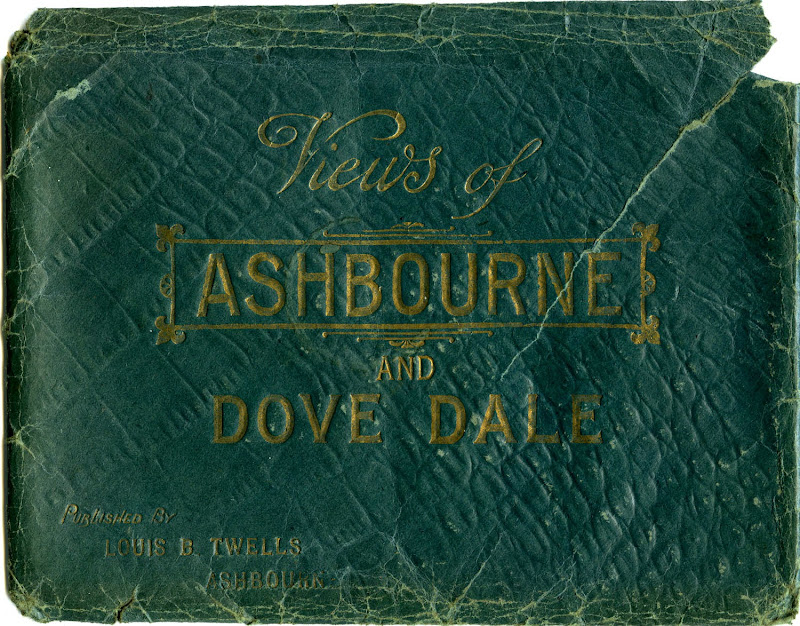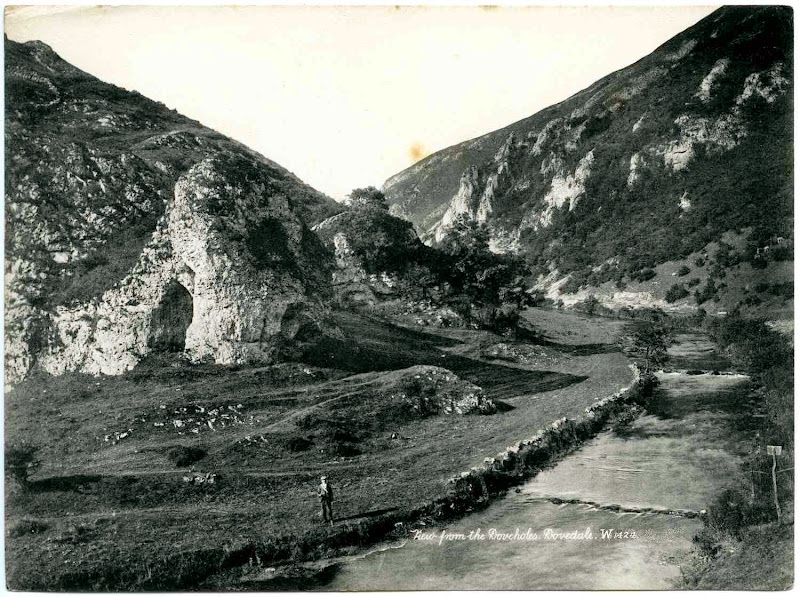
A couple of months ago I purchased a large collection of glass plate negatives, and used several of these to illustrate a piece I wrote for Sepia Saturday about a visit to the Pleasure Palaces of Southport. In the second of a planned series of articles about this intriguing collection we return to the English coastline with six colour positive glass plate slides taken by an unknown amateur photographer.
The six slides each measure 89 x 63mm (3½" x 2½"), with the printable area roughly 3¼" x 2¼", corresponding to the standard quarter-plate format used by most amateur glass plate cameras in the early to mid-1900s. All six are coastal views but, like the rest of the collection, none have anything to indicate where they might have been taken, despite having a very English feel to them.

It was this view that provided the first clue. As a trained geologist I'm pretty familiar with landscapes and outcrop patterns produced by a variety of rock types, and this headland with its blocky nature produced by weathering of rectangular joint patterns seems to me very typical of granite.

Geology of Cornwall and Devon
portion of Geological Survey "Ten-Mile" Map (1957)
Image © and courtesy of the Ordnance Survey
From what I remember of my A-Level geology studies the only place in England that you're likely to find granite right on the coast is in Cornwall, as the portion of the Geological Survey map for that area shows rather dramatically. The red blobs are granite intrusions, and the blob at the far left covers the land around Penzance, St Ives and Land's End.
Land's End, Cornwall
View Larger Map
That still leaves a fair distance of coastline to search, but if you're visiting Cornwall, what better place to take a photograph than at Land's End, that most touristic and memorable of spots, so that's where I looked first. You can search this coastline very effectively using either Google Maps or Google Earth. Noticing that the view in that first slide had some rocks off shore, with perhaps a lighthouse on one of them, I used Google Maps to come up with this view of rocky islets a few hundred metres to the west of Land's End.

Land's End, Cornwall
Image © Tom Hurley and courtesy of 360 Cities
Google Earth gives you the opportunity to "fly through" the landscape in virtual 3-D, and to access "spherical panoramic" images hosted by 360 Cities. One of these fortuitously shows almost the exact view as in the slide, taken from Dr Syntax's Head with the Longships islets and lighthouse, as well as Kettle's Bottom rock, in the distance.

Walking a few metres out to the headland and turning right to face north-east gives us the scene shown in the second of the slides (above). The rugged coastline is identifiable by the characteristic sea arches, and a hotel building just visible on the horizon. These two panoramas can be viewed via browser on the 360 Cities web site here and here.

Harbour View A
The next three slides show a harbour, taken from different spots around the shoreline. This image is the most interesting, and in some ways frustrating, of the three. A large crowd gathers around something almost hidden from the view of the photographer. In the right foreground a neatly dressed woman pats the neck of a horse, complete with full collar and harness attached to the shafts of the cart, the buckboard of which is just visible through the crowd. Clearly the people are jostling for a closer view of whatever is on the cart. One man, wearing rolled up shirt sleeves and a flat cap, is standing at what is probably the tailgate of the cart, and has the attention of many in the crowd. At far left of the foreground, standing on some kind of platform, are three teenagers including two girls with dark blue school blazer, one with an unidentifiable crest.
A lorry with large drums piled on the back is parked between the crowd and the water. Almost hidden behind the cab of the truck, several boys play in waist-deep water. The harbour is scattered with boats at anchor, ranging from small pleasure craft to larger commercial fishing boats. A long stone wharf or breakwater extends almost across the entire width of the photo, with two lighthouses, a large one centrally placed and a smaller one at the distal end, marking one side of the harbour entrance. A couple of dozen cars, mostly black, are parked along the wharf, reminding one of that well worn quote often attributed to Henry Ford, "You can have any colour as long as it's black." The car at the far right looks like an early Morris Minor, first manufactured in 1948. Also arrayed intermittently down the wharf are a number of people standing and sitting, obviously enjoying the warm sunshine.

Harbour View B
This view of the harbour includes the shore-end of the wharf and part of a town, with a number of boats resting at anchor and several dinghies tethered by ropes and lying on the sand in the foreground exposed by an outgoing tide.

Harbour View C
A third view of the harbour is taken from the opposite direction, the photographer standing on the shore somewhere in the middle of the previous view. Boats are at anchor or under way in the small harbour, at least four of them with visible occupants, and several men, women and children can be seen on foot investigating the intertidal sand flats.
The slopes on the other side of the harbour are clad with a substantial number of buildings, indicating a sizeable town, and a smaller wharf protecting the other side of the harbour is visible in the left middle ground. At far left in the middle ground, beyond a rocky point, a beach crowded with pleasure seekers can just be made out.

St Ives, Cornwall, December 2005 (see in Google Maps)
It took a little searching, but I eventually found the harbour using Google Earth. It is St Ives, situated on the northern Cornwall coast, a town well serviced with Streetview images, which meant I could locate three perfect shots for a "Now and Then" series.

St Ives Harbour View A - May 2009
Image © and courtesy of Google Earth
The first view was clearly taken near the top of this boat ramp, and I suspect the cart contains a catch of fish, crab or lobster recently hauled onshore from one of the fishing boats now at anchor in the harbour.

St Ives Harbour View B - May 2009
Image © and courtesy of Google Earth

St Ives Harbour View C - May 2009
Image © and courtesy of Google Earth
The second and third views indicate that the photographer was walking around the harbour as the tide went out.

The last of the six slides depicts a beach at low tide, filled with dozens of people enjoying the sunny afternoon. Some recline in their deck chairs, reading newspapers, chatting to friends or watching the children playing. The photographer has caught a young boy having just bowled a ball at his sister, and she's in the act of batting it away. Two young ladies bravely sunbathe in the lea of a rocky outcrop. Another group of children are digging in the sand. One young man or woman scans the sky anxiously, wondering how much longer the sun will last or perhaps keeping a lookout for pesky seagulls.

View of Newquay Harbour entrance from Towan Beach
Image © buthe79 and courtesy of Panoramio
This has been identified as Town Beach at Newquay, which recent images show to have remained popular with holidaymakers. The rocks here are Devonian sandstones, by the way.
The clothing fashions in these photographs, particularly those worn by the women, appear to me to be typical of the post-Second World War era, i.e. the late 1940s and early to mid-1950s, illustrated by the images on Geoff Caulton's PhotoDetective web page for this period.

Detail of St Ives Harbour View A
Image © and collection of Brett Payne
It was when zooming in on these images that I noticed a very unusual feature, one that I've never previously noticed in any of the colour images that I own. Although not visible to the naked eye, the colours are actually made up of three differently coloured sets of diagonal lines. According to Robert Hirsch's history of colour photography (Hirsch, 2011), colour plates made up of a "checkerboard of red, green, and blue elements" were produced by the Finlay Colour process, also known as the Thames Colour Screen, which was originally patented in 1906 but abandoned after the Great War. It was subsequently re-introduced in the late 1920s and early 1930s.
The Paget Dry Plate process, "patented in Britain in 1912 by G.S. Whitfield and first marketed by the Paget Prize Plate Company in 1913," was a very similar technique (Wikipedia).
The system used two glass plates, one of which was the colour screen plate while the other was a standard black-and-white negative plate. The colour screen plate comprised a series of red, green and blue filters, laid down in a regular pattern of lines to form a réseau, or matrix ... Transparency positives could be made from the system's panchromatic negatives by contact printing; these positives were then bound in register with a colour viewing screen of the same type as used for exposure, to reproduce the image in colour.James Morley has a small collection of early colour positive slides produced by the Paget process here. My examples, however, appear to have been taken considerably later, probably in the very late 1940s or early 1950s.
For more coastal excursions, in various hues, visit the other participants in this week's Sepia Saturday effort.
References
Hirsch, Robert (2011) A Concise History of Color Photography, in Exploring Color Photography, 5th Edition, Focal Press.
Elusive colour: Paget colour system, on Captured in Colour, Australian War Memorial.











































